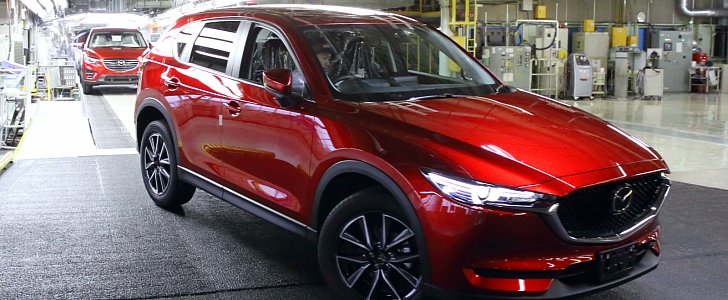28 November 2016, the Ujina No. 2 plant near Mazda’s headquarters in Hiroshima started production of the all-new CX-5. To go on sale in Japan in February 2017, the second iteration of the compact crossover will then roll out in the rest of the world.
Launched in 2012 and manufactured until recently, the original CX-5 sold almost 1.6 million units during its lifecycle. Now accounting for nearly 25 percent of the automaker’s annual volume, the CX-5 story is far from over.
For 2017, Mazda gifted the all-new CX-5 with a bolder take on the Kodo - Soul of Motion design language. To some, the front fascia may resemble Red from Angry Birds a bit too much. To others, the eye-catching face of the CX-5 is a selling point because, well, the CX-5 looks the part. What I like most about the new kid on the block from a design standpoint is the outline of the side windows, which has that certain airy, station wagon feel to it.
The rear end is pretty much the CX-9 xeroxed at 75 percent, while the cabin shares many of its bits and bobs with the CX-9 as well. Minus the interior door panels, air vents, and upper part of the dashboard, everything else is pretty much a carbon copy of what the CX-9 boasts with. From the shape of the gear lever to the HVAC controls, instrument panel, steering wheel, and infotainment system included, it’s pretty hard to separate the two crossovers.
As an evolution of the original CX-5, the 2017 Mazda CX-5 promises more of everything, including handling dynamics. Thanks to high-strength steel, engineers achieved 15.5 percent higher structural rigidity compared to the first-generation model. G-Vectoring Control is another bonus, albeit that’s more of a safety feature rather than a dynamic enhancer for keen drivers.
In the U.S., the 2017 Mazda CX-5 will be made available with SkyActiv-G powerplants (2.0 and 2.5 liters), mated to either a 6-speed manual or a 6-speed automatic transmission. Sometime in 2017, Mazda will add the 2.2-liter SkyActiv-D clean diesel for the fuel economy-minded buyer. I had the opportunity to test the oil-chugging powerplant in a Euro-spec CX-5 and, to its defense, it’s a thoroughly reasonable means of propulsion.
For 2017, Mazda gifted the all-new CX-5 with a bolder take on the Kodo - Soul of Motion design language. To some, the front fascia may resemble Red from Angry Birds a bit too much. To others, the eye-catching face of the CX-5 is a selling point because, well, the CX-5 looks the part. What I like most about the new kid on the block from a design standpoint is the outline of the side windows, which has that certain airy, station wagon feel to it.
The rear end is pretty much the CX-9 xeroxed at 75 percent, while the cabin shares many of its bits and bobs with the CX-9 as well. Minus the interior door panels, air vents, and upper part of the dashboard, everything else is pretty much a carbon copy of what the CX-9 boasts with. From the shape of the gear lever to the HVAC controls, instrument panel, steering wheel, and infotainment system included, it’s pretty hard to separate the two crossovers.
As an evolution of the original CX-5, the 2017 Mazda CX-5 promises more of everything, including handling dynamics. Thanks to high-strength steel, engineers achieved 15.5 percent higher structural rigidity compared to the first-generation model. G-Vectoring Control is another bonus, albeit that’s more of a safety feature rather than a dynamic enhancer for keen drivers.
In the U.S., the 2017 Mazda CX-5 will be made available with SkyActiv-G powerplants (2.0 and 2.5 liters), mated to either a 6-speed manual or a 6-speed automatic transmission. Sometime in 2017, Mazda will add the 2.2-liter SkyActiv-D clean diesel for the fuel economy-minded buyer. I had the opportunity to test the oil-chugging powerplant in a Euro-spec CX-5 and, to its defense, it’s a thoroughly reasonable means of propulsion.


No comments:
Post a Comment